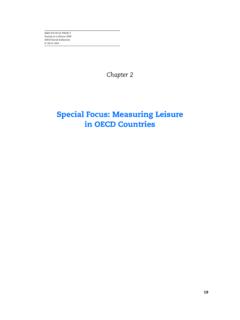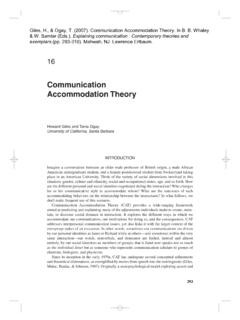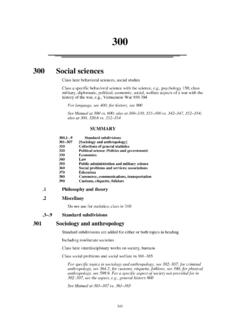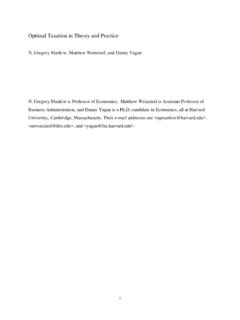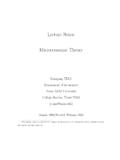Transcription of Exploring the Uses and Gratifications Theory in the Use of ...
1 Malaysian Journal of Distance Education 17(2), 83 95 (2015) Penerbit Universiti Sains Malaysia, 2016 Exploring the Uses and Gratifications Theory in the Use of Social Media among the Students of Mass Communication in Nigeria Aisar Salihu Musa1*, Mohd Nazri Latiff Azmi2 and Nur Salina Ismail3 1 Kano State Polytechnic, Nigeria 2,3 Faculty of Languages and Communication, Sultan Zainal Abidin University, Malaysia Published online: 29 August 2016 To cite to this article: Aisar Salihu Musa, Mohd Nazri Latiff Azmi and Nur Salina Ismail. 2015.
2 Exploring the uses and Gratifications Theory in the use of social media among the students of Mass Communication in Nigeria. Malaysian Journal of Distance Education 17(2): 83 95. doi: To link to this article: Abstract For decades, the Uses and Gratification (U & G) Theory has been the main Theory of communication that explains what people do with the media. To many, the Theory seems old. However, the emergence of social media breathes a new life into this aging Theory . This paper seeks to explore the current functions of the U & G Theory in the students use of social media.
3 Survey and focus group discussion were used to elicit information from purposively selected 111 final year students of mass communication. The paper discovers that majority of the respondents ( ) used social media for communication, collaboration, news sharing, research, expression of opinion, maintaining a connection, and making friends from other countries. Facebook and WhatsApp were the most preferred social networks among the respondents. The paper confirms that social media platforms have revived the functions of the U & G Theory and provided a plethora of media uses that the traditional media never could.
4 Very few of the respondents used social media for information, to investigate why, the paper suggest that the Media Information Utility Theory should be thoroughly investigated. Keywords: social media, uses and gratification Theory , usage of social media 84 Malaysian Journal of Distance Education 17(1), 83 95 (2015) Introduction Social media become an area of interest to researchers, marketers, students, celebrities, and many other economic and socio-political institutions. This has to do with the belief that the power of globalisation has forced many people to be online in order to cope and survive with the demand of the 21st century technology.
5 Nowadays, millions of people do their activities on social media because they have the opportunity to view, read, seek, and share whatever they like, anywhere, anytime, and on any topic (Vicen and Cavus, 2010, Papoola, 2014). As Internet penetration keeps widening (with over billion users of the Internet today) and social media platforms continue proliferating, Whiting and Williams (2013) claimed that there is a little knowledge of why and how people use social media which is the basic foundation of the Uses and Gratifications Theory .
6 Some scholars (such as Ruggiero, as cited in Gallion, 2010) predicted that the emergence and widespread usage of the Internet would come with new changes in roles, personal, and social habits of media users. This diversification of the use of media is what promotes the U & G Theory . Similarly, Stafford et al. (cited in Anaeto, Onabajo and Osifeso, 2008), buttressed that the emergence of new media and computer-mediated technologies have rejuvenated the Uses and Gratification Theory and also provide a new wave of scholarship.
7 Students are described as the major users of social media. Therefore, the Uses and Gratification Theory is an ideal Theory to identify and analyse the reasons why they use social media (Whiting and Williams, 2013; Yoo and Kim, 2013). Furthermore, applying the U & G Theory in social media studies is of great importance because these new forms of mass media are somewhat new in relation to old media. Unlike the traditional media that provided users with limited choices, these new media come up with new options, and the Theory will assist to explain the users needs and the Gratifications achieved (Gallion, 2010; Matei, 2010).
8 As there are limited studies to revalidate the U & G Theory in relations with social media, therefore, this paper intends to apply the U & G Theory to help to explain whether the students are using social media and why, and the Gratifications they achieved. For these reason, this paper seeks: 1. To investigate whether the students use social media The U & G Theory in the Use of Social Media among Students 85 2. To examine the social networks preference among the students 3. To demonstrate the relevance of the U & G Theory in the students use of social media Literature Review Social Media The most popularly cited definitions of social media is given by Kaplan and Haenlein (2010: 61), as a group of Internet-based applications that build on the ideological and technological foundations of Web and that allow the creation and exchange of user-generated content.
9 Furthermore, Douglas (cited in Papoola, 2014) views social media as any digital media that can be used to share messages, photos, news, information, music, and videos with cyber communities. For this reason, social media heavily relied on mobile applications and websites created for social interactions which allow users to generate, express, and share information about themselves or others. Considering this, social media are numerous, diverse, available, cheap and almost free to use. Wikis, Micro-blogging, Online Forums, Online blogs, and Social Networking Sites (SNSs) are among the most popular social media technologies.
10 Similarly, as some people used these technologies for educational purposes, majority are online for interaction and information sharing. The typical examples of social media are Twitter, Blogs, Facebook, Google+ LinkedIn, Wikis, Pinterest, YouTube and Flikr (Lewis, 2009; Osatuyi, 2013; Whiting and Williams, 2013). Uses and Gratifications Theory Katz, Blumler and Gurevitch pioneered the Uses and Gratification Theory in 1974. But according to McQuail (2010), the Theory could be traced from the early 1940 s when researchers started investigating why people listen to popular radio programmes and why they read newspapers daily.
